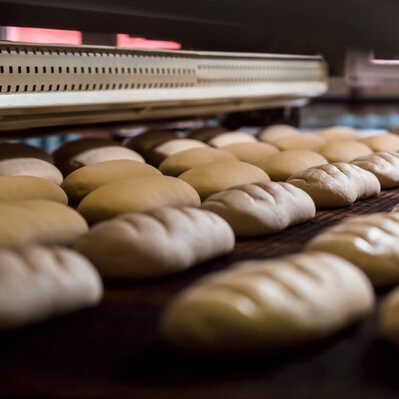
Tunnel Oven
Also known as continuous oven
What is a Tunnel Oven?
Tunnel ovens are continuous baking equipment which can be either direct gas-fired (DGF) or indirect heating units.The heart of high-speed production lines, they usually define the output capacity of the plant. Dividers, proof boxes, cooling towers and bagging equipment are balanced against the output that tunnel ovens are capable of producing.
Tunnel ovens provide:
- Versatility
- Productivity
- Reduced labor
- Opportunities to expand existing capabilities
Origin
Tunnel ovens have been used in large-scale bakeries for decades. The first models were commercially launched by Baker Perkins and Werner and Pfleiderer in the early 1930s and ‘40s. Later on, other oven manufacturers started to create alternative designs or improve existing models.
How it works
A tunnel oven requires 5 basic and minimum components for its operation:1
- A enclosed and thermally insulated box which functions as the baking chamber to prevent heat leaks and maintain process temperature
- A heating mechanism which in most cases involves combustion of fossil fuels
- A convection system that forces the circulation of hot air inside baking chamber
- A transmission system (motor, shaft, pulley, gearbox and band) to make products move from one end to the other across baking chamber length
- Extractors or exhaust stacks to safely remove products of combustion and prevent water vapor accumulation inside baking chamber
- A loading and unloading system which orientates pans so that these can be grouped and sent as discrete rows
Thermal output required for baking different baked goods in tunnel ovens:
- Bread and buns → 400 – 500 BTU per pound of dough
- Cakes and sweet baked goods → 350 to 450 BTU per pound of batter
- Soda and snack crackers → 900 – 1000 BTU per pound of dough
Direct gas fired (DGF) tunnel ovens are the most common type of equipment in high-speed bakeries producing either bread or cakes. DGF tunnel ovens are versatile and simple to operate. The following table summarizes the % efficiency or relative heat utilization of DGF tunnel ovens for pan bread:
| Item | % Total heat produced by combustion |
|---|---|
|
Heat for baking the product (Dough-to-crumb transition and moisture reduction) |
41.0 |
| Heating of pan and lid | 15.0 |
| Heat leakage through oven wall insulation | 10.0 |
| Radiant heat emitted by outer covers | 2.0 |
| Band return cycles | 10.0 |
|
Exhaust system (Blowers running at 60 Hz) |
22.0 |
Application
Key design aspects when selecting tunnel ovens
- Capacity / price ratio
- Type of product application and required output in pieces per minute or lbs dough / h
- Width and length according to required output, pan dimensions and product spacing
- Heating mechanism (natural or propane gas combustion, electricity, hydrogen)
- Thermal capacity in BTU / h or KW for baking and drying dough or batter
- Thermal insulation of baking chamber (thermal conductivity and thickness of insulation materials)
- Altitude above sea level (dictates maximum product temperature and affects the performance of pneumatic equipment, such as extraction blowers and turbine for combustion air)
- Convection system for forcing the movement or circulation of hot air
- Transmission system
- Band construction and mechanical strength to support full load, stress forces and thermal expansion (solid steel band, wire-mesh, grid-type)
- Oven efficiency or relative heat utilization
- Oven safety and alarm systems
- Process instrumentation and control
Approaches to reduce heat consumption in tunnel ovens
- Increase insulation thickness
- Use insulators with lower thermal conductivities
- Use lighter pans and lids
- Install lighter bands or conveyor grids
- Optimize exhaust rates based on minimum requirements for extracting combustion gases and water vapor
References
- Davidson, I. Biscuit Baking Technology. Processing and Engineering Manual, 2nd edition, Academic Press, 2013.

